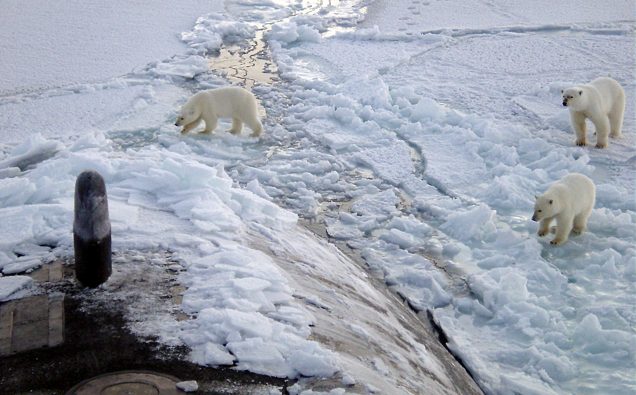
Photo: U. S. Navy by Chief Yeoman Alphonso Braggs/Wikimedia
It’s not really “news” to say that it’s hot in the summertime. Scientists have been making news for some time, though, saying that in recent decades the overall climate of planet Earth has been getting hotter – and that it might be our fault.
Is global warming caused by the human use of fossil fuels and the release of enormous amounts of carbon dioxide into the atmosphere? Or, are temperatures rising because of naturally-occurring phenomena as in the past, recorded in the Earth’s geologic record over millions of years – such as changes in solar radiation, intense volcanic activity, and shifts in the Earth’s rotation around the Sun? A growing body of scientific research blames hotter weather on human beings and our increased use of carbon-based fuels – coal, oil, and natural gas – but the lack of easy alternatives has led to an increasingly heated political debate.
And while that debate goes on, and governments move slowly toward alternative energy sources, temperatures continue to rise just about everywhere on Earth – across continents, the world’s oceans, in heavily populated areas, and in places without human settlements. In cities and open farmland, rising heat levels have caused more than a little discomfort: in the Middle East and South Asia, midday temperatures this year are ranging from 43 to 51 degrees Celsius, causing people to avoid work outdoors when the sun is high in the sky.
In unpopulated polar regions, warming ocean waters are redirecting major currents of air and water, resulting in higher temperatures in the atmosphere and less snowfall in winter months. The coldest place on Earth this summer has been very cold, indeed – minus 17 to minus 26 degrees Celsius in Greenland, the world’s largest island covered by a permanent ice sheet more than a mile thick. Greenland – bordering the Arctic and Atlantic Oceans – has a small population living in coastal towns and cities, and they are used to cold weather for most of the year. They are noticing, however, that their weather is getting warmer, too.
Residents of Greenland – like scientists, and people in northern Canada, Alaska, and the coastal regions of Northern Europe – have witnessed a gradual thawing in the normally icy areas of the Arctic Ocean. The Arctic region, in fact, has been warming at about twice the rate of the rest of the planet, and late last year climatologists noted the loss of a mass of sea ice equal in size to the states of Texas and Alaska combined. Temperatures around the North Pole last November were recorded at 20 degrees Celsius – balmy weather for most people – and a sailboat was able to circumnavigate the Arctic Ocean through the Northwest and Northeast Passages without getting stuck in ice.
The loss of ice in the Arctic Ocean – and the disappearance of the ice cap long identified with the North Pole – means several things to scientists who study the temperatures and currents of ocean waters. First, the sun’s rays that used to reflect heat off the ice into the atmosphere are now warming up the Arctic sea, bringing changes in deep cold water currents headed northward – and long-term changes for the weather in northern Europe. Second, as the ocean gets warmer, ice that forms at the start of winter will not be as thick as in years past, causing further changes in air pressure systems, temperature cycles, and weather patterns in land masses bordering the Arctic Circle. Third, there is a noticeable shift in the migratory patterns of fish, an ominous sign for populations that depend on sea life as a source of food. Last, an ironic consequence of melting Arctic Sea ice is that underwater oil drilling in the region will be much easier.
Despite measurable trends, predicting the weather remains as much an art form as a science, and scientists were puzzled late last year by an anomaly in northern Siberia. While ice was melting rapidly in the Arctic, and a boat was sailing around the North Pole, temperatures were plummeting across a dozen time zones from northern Europe to eastern Asia. Instead of light jackets people huddled in fur coats, with some cities staying below zero degrees Fahrenheit for weeks at a time – and no indication when conditions might change. Pressed for an explanation, meteorologists blamed it on weather patterns caused by global warming.
“There are some pretty crazy things going on in the Arctic right now,” said Mark Serreze, Director of the National Snow and Ice Center in Colorado, “and we’re still trying to figure it all out.”
As for the bottom of the world – Antarctica, with its ice cap and glaciers and sub-freezing temperatures throughout the South Pole region – the air and ocean waters are warming up there, too. In early July a gigantic chunk of ice – four times the size of the city of London – broke off the edge of a massive glacier, and more could follow in the months ahead. There’s debate as to what all that will mean for a possible rise in sea levels, but that’s true of just about everything having to do with climate change. And that’s a story for another time.


















